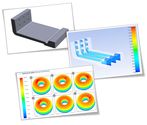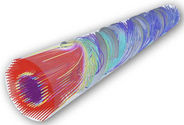-
About
- About Listly
- Community & Support
- Howto
- Chrome Extension
- Bookmarklet
- WordPress Plugin
- Listly Premium
- Privacy
- Terms
- DMCA Copyright
- © 2010-2025 Boomy Labs

 Mehul Patel
Mehul Patel
Listly by Mehul Patel

Almost every industry involves the utilization of pipes, ducts and manifolds to handle wide range of fluids, gases or a mixture of solids and fluids. It is evident that these transport mediums are exposed to critical pressure and temperature, requiring thorough study on their designs to ensure longevity and performance.

Cavitation is a widely known problem associated with pumps, causing severe impact in overall performance as well as malfunctioning due to improper pump inlet conditions. As such, it is highly important for a pump user to know what cavitation is, its effects and possible ways of controlling it using modern simulation techniques such as CFD.

Posted by: Mehul Patel | Posted on: December 16th, 2014 Automobiles are largely composed of components that directly or indirectly possess relationship with heat transfer. Although heat is essentially required to churn out power from the engine, rest of the components are being incorporated to accommodate or transfer the generated heat, once it completes the job of producing necessary power.

Computational fluid dynamics (CFD), allows engineers to visualize flow velocity, density, thermal impact and chemical concentrations for any region where the flow occurs. This in-turn helps engineers analyze the problem areas and suggest the best solutions. CFD is widely used across the construction industry for analysis and design optimization of an HVAC system.

The use of Computational Fluid Dynamics (CFD) to resolve engineering challenges has been phenomenal in the last decade. Engineers are progressively relying on computational models to evaluate their product design, expecting sizeable reduction in the product development cycle. Despite the horde of advantages the CFD approach offers, there has been severe criticism on taking the simulation results for granted.

Exhaust gas streams emitting from industrial process plants consist of harmful pollutants, which are carried away for sufficiently large distances from the source. The control of these pollutants dispersion is mandatory to avoid spreading of toxic gases into urban areas nearer to plant locations.

The potential of CFD simulations is increasingly being exploited in many modern engineering fields. However, the use of CFD techniques is more restricted to manufacturing domains, to study and optimize the performance of equipments and systems involving fluid flows. Yet, recent advancements in scanning and computing technologies have opened a whole new set of opportunities in biomedical engineering field.

Wind tunnels have been one of the prominent testing tools for aerodynamic investigations. However, its use is limited mainly due to the cost required in physical setup. Additionally, these tests are time consuming and stretched the product design cycle considerably. Fortunately, use of computational tools such as CFD provides a solution against the problems associated with physical wind tunnel tests.
Computational fluid dynamics (CFD) has remained a vital tool for aircraft design assessment ever since its inception. Its use has already brought a paradigm shift in the aircraft design process.






Computational Fluid Dynamics (CFD) simulation has long had a reputation of being too difficult, slow and expensive to be performed in the main stream design process. That may be true a decade ago but things have drastically changed recently. Yet there are certain myths associated with CFD in the early phases of mechanical design.

The world is badly in a need of products that are energy efficient, as global energy consumption levels increase at an alarming rate. It is the only reason why government agencies and manufacturing organizations are strained to look for possible alternatives that consume less energy.
